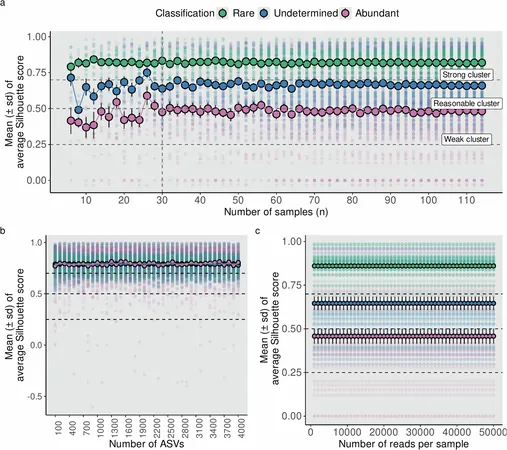
Revolutionizing Microbiome Research: Meet ulrb, the AI Tool Uncovering Rare Microorganisms
2025-04-09
Author: Arjun
Unlocking the Secrets of the Microbial World
Identifying rare microorganisms in microbiome data has taken a giant leap forward, thanks to an innovative AI-driven tool developed by a dedicated team of researchers from Portugal and Canada. Say hello to ulrb, the groundbreaking software that leverages machine learning to autonomously detect those elusive organisms hidden within ecological datasets.
A Game-Changer for Microbial Ecology
The mission of ulrb is clear: to swiftly and automatically pinpoint rare microorganisms in microbiome samples, addressing a long-standing challenge in the field of microbial ecology — differentiating rare species from their more populous counterparts.
This pioneering methodology has recently been unveiled in the journal Communications Biology, under the article "Definition of the microbial rare biosphere through unsupervised machine learning." Such an important study highlights an international collaboration that spans across renowned institutions, including the Interdisciplinary Center for Marine and Environmental Research (CIIMAR) in Portugal, and the Faculty of Computer Science at Dalhousie University in Canada.
The Importance of Rare Microorganisms
What exactly is the rare biosphere? In microbial communities, a few species dominate in numbers, while countless others exist in low abundance, constituting the elusive "rare biosphere". It may surprise you to learn that a mere liter of seawater can harbor thousands of prokaryotic species, yet only 2% to 5% of these are commonly abundant.
Despite their scarcity, these rare microorganisms are the bedrock of genetic diversity on our planet, providing essential resilience to ecosystems. According to researcher Francisco Pascoal, these rare species may rise to prominence when their more abundant counterparts are threatened by environmental changes, making their role critical in maintaining ecosystem stability.
How ulrb Works: The Magic of Machine Learning
So how does ulrb accomplish this remarkable feat? Utilizing unsupervised machine learning techniques, the platform can quickly and accurately identify rare microorganisms within diverse communities. A key advantage is its adaptability; the algorithm learns from the data patterns themselves, irrespective of their source.
Pascoal explains, "The ability to identify these microorganisms emerged with high-throughput DNA sequencing technologies, but previous methods often left scientists scratching their heads. Our tool takes the guesswork out of it by leveraging sequencing data to delineate which microorganisms are rare, all rooted in the nuances of each sample's information."
From Microbes to Biodiversity: Applications of ulrb
The potential applications of ulrb are vast. This tool is not only tailored for analyzing microbial ecology samples but also has implications for studying emerging diseases, biological invasions, and could even extend to monitoring endangered animal and plant species.
For researchers eager to dive into the world of rare microorganisms, ulrb is readily available as an open-source R package via CRAN and GitHub, accompanied by a dedicated website offering learning materials to facilitate its use.
The Future of Ecosystem Research
In conclusion, ulrb is set to revolutionize our understanding of microbial diversity and resilience in ecosystems. By automating the identification of rare microorganisms, this tool not only bolsters ecological analyses but also contributes significantly to the ongoing dialogue about biodiversity in the face of climate change.

 Brasil (PT)
Brasil (PT)
 Canada (EN)
Canada (EN)
 Chile (ES)
Chile (ES)
 Česko (CS)
Česko (CS)
 대한민국 (KO)
대한민국 (KO)
 España (ES)
España (ES)
 France (FR)
France (FR)
 Hong Kong (EN)
Hong Kong (EN)
 Italia (IT)
Italia (IT)
 日本 (JA)
日本 (JA)
 Magyarország (HU)
Magyarország (HU)
 Norge (NO)
Norge (NO)
 Polska (PL)
Polska (PL)
 Schweiz (DE)
Schweiz (DE)
 Singapore (EN)
Singapore (EN)
 Sverige (SV)
Sverige (SV)
 Suomi (FI)
Suomi (FI)
 Türkiye (TR)
Türkiye (TR)
 الإمارات العربية المتحدة (AR)
الإمارات العربية المتحدة (AR)